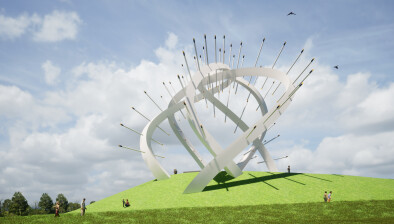And finally… Forth Bridge tops list as Scotland’s greatest man-made wonder
 Some of Scotland’s most eclectic and diverse sights, from a 12th century monastery and iconic medieval castles to landmarks of Victorian architectural prowess and engineering feats of the 21st century, have been voted by the public among top 10 man-made wonders in the country.
Some of Scotland’s most eclectic and diverse sights, from a 12th century monastery and iconic medieval castles to landmarks of Victorian architectural prowess and engineering feats of the 21st century, have been voted by the public among top 10 man-made wonders in the country.
New research by VisitScotland and as part of the Year of Innovation, Architecture and Design 2016, saw the 126 year old Forth Rail Bridge take the top spot, with 30 per cent of the votes in the survey.
Edinburgh Castle was named the second greatest ‘wonder’ of Scotland with the Scott Monument in eighth place. The other ‘wonders’ on the Top 10 list include Stirling Castle, the Falkirk Wheel, Caledonian Canal, Bell Rock Lighthouse and Melrose Abbey.
Lying in the Tweed Valley in the charming town of Melrose, it’s easy to see why this ever-glorious ruin, with its lavishly decorated masonry, opens up this list.
It was founded by King David I in 1136, with the surviving remains of the church dating to the early 15th century, and is believed to be the burial place of Robert the Bruce’s heart. Admire the exterior’s hand-crafted decoration and view objects found during previous excavations.
Melrose Abbey is also often referred to as one of Scotland’s most beautiful buildings thanks to its sense of romance and charm. We heartily agree – do you?
Nearly 200 years after it was first built, the Bell Rock Lighthouse, popularly known as Stevenson’s Lighthouse, still stands – proudly flashing its warning light.
Located off Scotland’s east coast on a partially submerged reef, this impressive stone tower is the world’s oldest surviving sea-washed lighthouse and has not required a single repair or alteration to its stonework or design since the day it was built.
It’s often regarded as the most outstanding engineering achievement of the 19th century, and rightfully so. Make sure you visit it on your next trip to Scotland!
This Gothic memorial to literary beacon Sir Walter Scott in the heart of Edinburgh is not only the largest monument to a writer in the world, it’s also a gallery that houses an exhibition on his life and works amongst its sandstone walls.
Completed 170 years ago, this soaring beauty is over 200 ft high and its highest gallery is reached by climbing a spiral staircase of 287 steps to the top. From there you can enjoy superb views of the city and the surrounding countryside. You can even get a certificate to prove you made it to the top!
Take some time to appreciate the exterior side of Scott Monument, too, which is decorated with 64 carvings. All the statuettes represent characters from Scott’s novels. How many can you name?
Masterminded by Thomas Telford, the great Scottish engineer, the Caledonian Canal is considered by many to be one of the greatest waterways in the world.
Running just over 60 miles, it stretches from Inverness to Corpach near Fort William, slicing through the length of the majestic Great Glen and taking in some of the most breathtaking scenery that Mother Nature has endowed Scotland with. If you’ve not explored it yet, do it and savour a taste of the Highlands at their most dramatic.
Interestingly, only one third of the entire length is man-made, while the rest is formed by various lochs, including Loch Lochy and Loch Ness.
‘A rotating boatlift?’ we hear you ask. Yep! This wonderful, mechanical marvel raises vessels and connects the Forth & Clyde Canal and the Union Canal in central Scotland. It’s the only construction of its kind in the world!
Once vital for transportation, today the Falkirk Wheel is an iconic landmark that stands as a testament to the historical importance of Scotland’s waterways, as well as being an example of extraordinary engineering.
Climb onto a boat and soar gracefully 35 m in the air before smoothly landing on the Union Canal, and visit the newly revamped visitor centre where you will learn about the workings of this mighty wheel. Did you know… it only takes the power of about eight toasters for a full rotation?
Mounted high on a volcanic outcrop, Stirling Castle is one of Scotland’s grandest castles and was once a favoured residence of the Stewart kings and queens. Well, that’s hardly a surprise… Step into its enchanting interiors and you’ll see why.
From its sumptuous halls and beautiful gardens to the splendid Royal Palace which has recently been meticulously restored to its original Renaissance glory, a visit to Stirling Castle guarantees a grand and memorable day out. You will walk in the courtyard once frequented by Mary Queen of Scots, James V and Mary of Guise, and the kids will love playing dress-up in the palace vaults and meeting costumed courtiers, bodyguards and servants. The palace exterior, studded with beautiful sculptures, and its commanding views deserve a special mention, too.
Part of the legendary West Highland Line between Fort William and Mallaig (which is widely regarded as one of the greatest railway journeys in the world), the Glenfinnan Viaduct needs little introduction.
This iconic structure is made up of 21 arches that curve around the valley. It overlooks the Glenfinnan Monument and the waters of Loch Shiel and is surrounded by some of Scotland’s most splendid scenery. Simply picture-perfect!
You can admire it from the train (vintage steam trains also run in the summer months) or from a distance. Either way, it’s a great experience – not just for Harry Potter fans.
Designed by the Scottish sculptor Andy Scott, The Kelpies are the largest pair of equine sculptures in the world. Towering one hundred feet high above the Forth & Clyde Canal, the two colossal, glinting horse heads never fail to impress.
Made of 300 tonnes of shimmering galvanised steel each, those mighty metal beasts are a feat of engineering. Situated just off the M9, they mark the gateway to Scotland’s canals and are a monumental tribute to the horse power heritage that was vital to the early industries of central Scotland.
Perfect for a day out, or visit at night when they’re prettily lit up. Mesmerising! Did you know you can even go inside to marvel at the complexity and the engineering which created these fantastic pieces of art?
This stunning fortress dominates Edinburgh’s skyline and is unquestionably Scotland’s most famous castle. An unmissable part of any visit to the city.
Set atop a craggy extinct volcano, at the top of the cobbled and atmospheric Royal Mile, Edinburgh Castle is part of a World Heritage Site, and houses the Scottish Crown Jewels, the Stone of Destiny and Mons Meg. Get there in the early afternoon and you can also see (and hear!) the famous One O’Clock Gun!
It’s no fairytale castle, but when you see it you will understand why over a million visitors pass through its gates each year. It’s even been voted the UK’s best heritage attraction for a few years in the row!
And the winner is… certainly deserved!
The Forth Bridge is one of Scotland’s major landmarks and a UNESCO World Heritage Site. It’s a world-beating example of industrial engineering.
Whether it’s the sheer scale, innovative workmanship or architectural and engineering prowess, this magnificent railway bridge continues to impress 21st century visitors as much as it did when it was first erected and opened in 1890.
It was designed on the cantilever principle, with its three towers over 100 m high, and stretches one and a half miles over the Firth of Forth, connecting the coasts of Edinburgh and Fife. A truly spectacular sight to behold!














